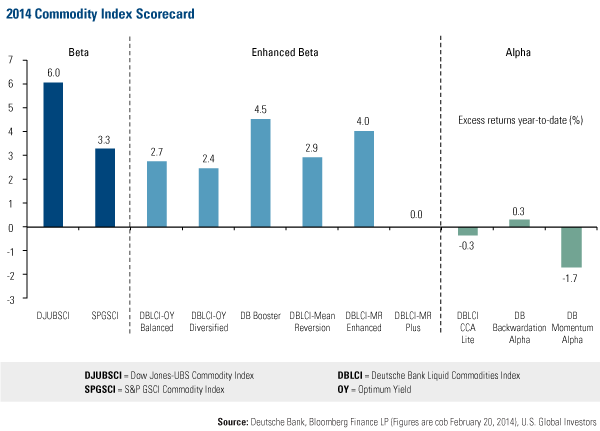Energy and Natural Resources Market (February 24, 2014)
Strengths
- Natural gas futures climbed to a five-year high of $6.40 during Thursday’s trading session after weather forecasts indicated that temperatures may be lower than normal in the eastern two-thirds of the U.S. heading into the first week of March.
- West Texas crude oil capped its sixth-weekly gain to $102 a barrel on strong heating oil demand.
- Arabica coffee futures jumped 21 percent this week in New York, extending their year-to-date gain to 56 percent due to dry weather conditions in Brazil, which is a leading global exporter of the commodity.
Weaknesses
- China Investment Corp. ($600 billion sovereign-wealth fund) is selling energy and commodity holdings, attempting to capitalize on recovering economies. According to regulatory filings, a total of $1.5 billion in shares in energy companies have been sold. The fund could also be considering selling stakes in oil-sands projects.
- Alcoa announced that it will permanently close its Point Henry aluminum smelter and rolling mills in Australia, after finding these have no prospects of becoming financially viable. Restructuring-related charges for 2014 with closures are expected between $250-270 million ($0.22-0.25/share) on an after-tax basis.
Opportunities
- Repsol will sign a definitive $5 billion settlement over the seizure of YPF within days, a source involved in the talks said, ending a two-year bilateral dispute. Argentine President Cristina Fernandez nationalized Repsol's majority stake in YPF in 2012, sparking a freeze on international investment in the prolific Vaca Muerta shale field.
- Asia is expected to be the end market for many of the planned global liquefied natural gas (LNG) projects. Projections by Qatargas and Wood Macenzie estimate Asian LNG demand by 2025 at 350 million metric tonne per annum (mmtpa), versus180 mmtpa currently. Traditional importers such as Korea and Japan are also expected to grow, but perhaps at a slower rate than in the past.
- Using forecast data through March 6, this U.S. winter remains the coldest since 2001 based on calculations of demand-weighted Heating Degree Days (HDD). Accordingly, it is estimated that the extent of the natural gas storage deficit will be large enough that by the start of next winter, storage levels may still be some 500 billion cubic feet below average even after assuming some production increase. The implication is that U.S. natural gas prices will need to remain high to incentivize utility switching to coal well into next winter.
Threat
- Despite record production of grains last year, agriculture enters the 2014 growing season with a "pretty tight" stock situation, said USDA Chief Economist Joseph Glauber, speaking yesterday at the USDA Agricultural Outlook Forum. "If problems arise this year," he said, referring to a potential production shortfall due to inclement weather or other exigencies, "we could see price spikes like we did in 2010 and 11."
















